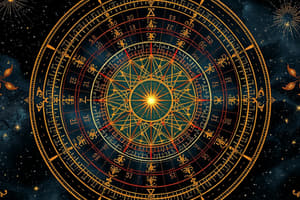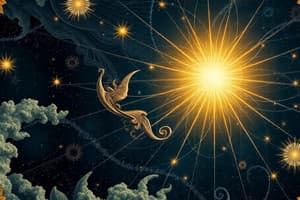Podcast
Questions and Answers
Imaginary patterns of stars are called ______________.
Imaginary patterns of stars are called ______________.
constellations
What are five characteristics used to classify stars?
What are five characteristics used to classify stars?
Color, temperature, chemical composition, brightness and size.
What reveals a star's temperature?
What reveals a star's temperature?
Its color
What is revealed by the red color of the supergiant star called Betelgeuse?
What is revealed by the red color of the supergiant star called Betelgeuse?
Stars that are much larger than the sun are called ____________.
Stars that are much larger than the sun are called ____________.
Each element has a unique set of lines on a spectrum.
Each element has a unique set of lines on a spectrum.
How can astronomers infer which elements are found in a star?
How can astronomers infer which elements are found in a star?
What does a spectrograph do?
What does a spectrograph do?
What is the chemical composition of most stars?
What is the chemical composition of most stars?
The amount of light a star gives off is called its ____________________.
The amount of light a star gives off is called its ____________________.
What two factors determine how bright a star looks from Earth?
What two factors determine how bright a star looks from Earth?
What is Apparent Brightness?
What is Apparent Brightness?
What is Absolute Brightness?
What is Absolute Brightness?
The closer a star is to Earth, the brighter.
The closer a star is to Earth, the brighter.
What two things must an astronomer find out in order to calculate a star's absolute brightness?
What two things must an astronomer find out in order to calculate a star's absolute brightness?
In space light travels at a speed of 300,000 km per year.
In space light travels at a speed of 300,000 km per year.
What is a light-year?
What is a light-year?
A light year equals about ________________ km.
A light year equals about ________________ km.
The light year is a unit of time.
The light year is a unit of time.
What is a parallax?
What is a parallax?
Astronomers use parallax to measure the distance to which of the following objects?
Astronomers use parallax to measure the distance to which of the following objects?
To measure parallax shift, astronomers look at the same star at two different times of year, when Earth is on different sides of the _________.
To measure parallax shift, astronomers look at the same star at two different times of year, when Earth is on different sides of the _________.
The diagram that shows the relationship between the surface temperatures of stars and their absolute brightness is called the _________________.
The diagram that shows the relationship between the surface temperatures of stars and their absolute brightness is called the _________________.
What is measured on the two axes of the Hertzsprung-Russell Diagram?
What is measured on the two axes of the Hertzsprung-Russell Diagram?
An area of the Hertzsprung-Russell Diagram that runs from the upper left to the lower right and includes more than 90% of all stars is ____________________.
An area of the Hertzsprung-Russell Diagram that runs from the upper left to the lower right and includes more than 90% of all stars is ____________________.
What sentence is true based on the Hertzsprung-Russell Diagram?
What sentence is true based on the Hertzsprung-Russell Diagram?
Flashcards are hidden until you start studying
Study Notes
Characteristics of Stars
- Constellations are imaginary patterns formed by groups of stars.
- Five key characteristics used to classify stars: color, temperature, chemical composition, brightness, and size.
- A star's temperature can be inferred from its color.
- The red color of Betelgeuse indicates it is a fairly cool star.
- Stars larger than the sun are classified as giants or supergiants.
- Each chemical element has a unique spectral fingerprint that is visible on a spectrum.
- Astronomers utilize spectrographs to determine the elements present in a star's composition.
- A spectrograph converts light into a spectrum of colors.
- Most stars are composed of approximately 73% hydrogen, 25% helium, and 2% other elements.
- Brightness refers to the amount of light emitted by a star.
- Two factors affecting a star's perceived brightness from Earth are its actual brightness and its distance from Earth.
- Apparent brightness is how bright a star appears from our planet.
- Absolute brightness denotes the brightness a star would have if positioned at a standard distance from Earth.
- Generally, closer stars appear brighter as seen from Earth.
- To calculate a star's absolute brightness, astronomers need its apparent brightness and distance from Earth.
- Light travels through space at about 300,000 kilometers per second, not per year.
- A light-year is a unit that measures the distance light travels in one year, approximately 9.5 trillion kilometers.
- Light-years are not a measure of time.
- Parallax is the perceived shift in an object’s position when observed from different angles.
- Astronomers apply parallax to measure distances of nearby stars.
- To measure parallax, observations are taken of the same star at different times of the year, as Earth orbits the Sun.
- The Hertzsprung-Russell Diagram illustrates the relationship between surface temperatures of stars and their absolute brightness.
- In the Hertzsprung-Russell Diagram, the x-axis represents surface temperatures while the y-axis represents absolute brightness.
- The main sequence is the region on the Hertzsprung-Russell Diagram that contains over 90% of all stars, running from the upper left to the lower right.
- True statements derived from the Hertzsprung-Russell Diagram include that the Sun is categorized as a main-sequence star and Polaris is brighter than the Sun.
Studying That Suits You
Use AI to generate personalized quizzes and flashcards to suit your learning preferences.




